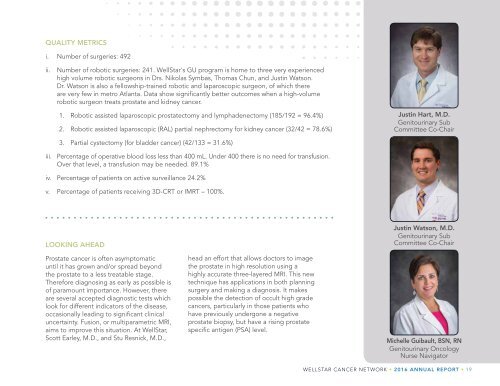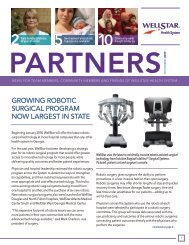WellStar Cancer Network 2016 Annual Report
Create successful ePaper yourself
Turn your PDF publications into a flip-book with our unique Google optimized e-Paper software.
QUALITY METRICS<br />
i. Number of surgeries: 492<br />
ii. Number of robotic surgeries: 241. <strong>WellStar</strong>'s GU program is home to three very experienced<br />
high volume robotic surgeons in Drs. Nikolas Symbas, Thomas Chun, and Justin Watson.<br />
Dr. Watson is also a fellowship-trained robotic and laparoscopic surgeon, of which there<br />
are very few in metro Atlanta. Data show significantly better outcomes when a high-volume<br />
robotic surgeon treats prostate and kidney cancer.<br />
1. Robotic assisted laparoscopic prostatectomy and lymphadenectomy (185/192 = 96.4%)<br />
2. Robotic assisted laparoscopic (RAL) partial nephrectomy for kidney cancer (32/42 = 78.6%)<br />
Justin Hart, M.D.<br />
Genitourinary Sub<br />
Committee Co-Chair<br />
3. Partial cystectomy (for bladder cancer) (42/133 = 31.6%)<br />
iii. Percentage of operative blood loss less than 400 mL. Under 400 there is no need for transfusion.<br />
Over that level, a transfusion may be needed. 89.1%<br />
iv. Percentage of patients on active surveillance 24.2%<br />
v. Percentage of patients receiving 3D-CRT or IMRT – 100%.<br />
LOOKING AHEAD<br />
Prostate cancer is often asymptomatic<br />
until it has grown and/or spread beyond<br />
the prostate to a less treatable stage.<br />
Therefore diagnosing as early as possible is<br />
of paramount importance. However, there<br />
are several accepted diagnostic tests which<br />
look for different indicators of the disease,<br />
occasionally leading to significant clinical<br />
uncertainty. Fusion, or multiparametric MRI,<br />
aims to improve this situation. At <strong>WellStar</strong>,<br />
Scott Earley, M.D., and Stu Resnick, M.D.,<br />
head an effort that allows doctors to image<br />
the prostate in high resolution using a<br />
highly accurate three-layered MRI. This new<br />
technique has applications in both planning<br />
surgery and making a diagnosis. It makes<br />
possible the detection of occult high grade<br />
cancers, particularly in those patients who<br />
have previously undergone a negative<br />
prostate biopsy, but have a rising prostate<br />
specific antigen (PSA) level.<br />
Justin Watson, M.D.<br />
Genitourinary Sub<br />
Committee Co-Chair<br />
Michelle Guibault, BSN, RN<br />
Genitourinary Oncology<br />
Nurse Navigator<br />
WELLSTAR CANCER NETWORK • <strong>2016</strong> ANNUAL REPORT • 19

















